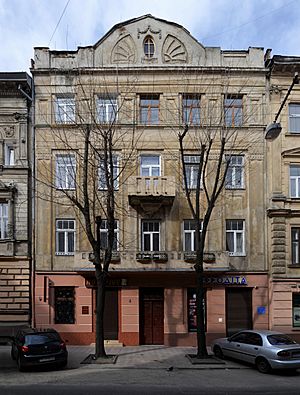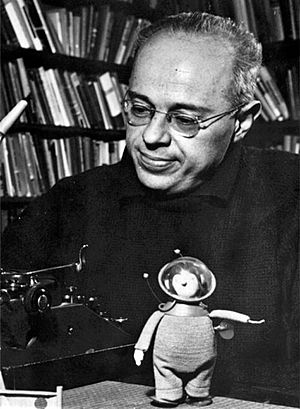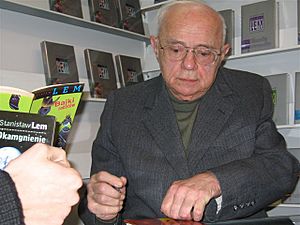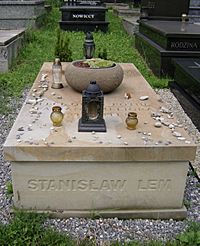Stanisław Lem facts for kids
Quick facts for kids
Stanisław Lem
|
|
|---|---|

Lem in 1966
|
|
| Born | Stanisław Herman Lem 12 September 1921 Lwów, Second Polish Republic (now Lviv, Ukraine) |
| Died | 27 March 2006 (aged 84) Kraków, Poland |
| Occupation | Writer |
| Nationality | Polish |
| Period | 1946–2005 |
| Genre | Hard science fiction, philosophy, satire, futurology |
| Spouse | Barbara Leśniak (1953–2006; his death; 1 child) |
| Signature | |
 |
|
|
Philosophy career |
|
|
Notable work
|
|
| School |
|
|
Main interests
|
|
Stanisław Herman Lem (born September 12, 1921 – died March 27, 2006) was a famous Polish writer. He wrote many science fiction stories and essays. His essays covered topics like philosophy and what the future might look like.
Many of his science fiction stories were funny and made fun of things. Lem's books have been translated into over 50 languages. More than 45 million copies have been sold worldwide. He is most famous for his 1961 novel Solaris. In 1976, another writer, Theodore Sturgeon, said Lem was the most read science fiction writer globally.
Lem also wrote a very important book called Summa Technologiae. In this book, he imagined things like virtual reality and artificial intelligence long before they existed. He also thought about how humans might change themselves and create artificial worlds.
His science fiction stories often explored big questions. They looked at technology, what it means to be intelligent, and how hard it is to talk to alien intelligence. He also wrote about human limits and our place in the universe. His essays covered these and many other ideas.
It can be hard to translate his books because Lem made up many new words. He also used clever wordplay. In 2021, the Polish Parliament declared it the "Stanisław Lem Year" to honor him.
Contents
Lem's Life Story
Growing Up in Poland

Stanisław Lem was born in 1921 in Lwów, which was then part of Poland. Today, this city is called Lviv and is in Ukraine. He later said he was actually born on September 13th. But the date on his birth certificate was changed to the 12th because of an old belief about bad luck.
His parents were Sabina and Samuel Lem. His father was a wealthy doctor who specialized in throats. Lem was also a cousin to the Polish poet Marian Hemar. Lem sometimes said he was raised Catholic. However, he took Jewish religious lessons when he was in school. Later, he decided he didn't believe in God. He said the world seemed too painful to have been made on purpose. He called himself both an agnostic and an atheist.
In 1939, the Soviet Union took over parts of Poland. Lem wanted to study at Lwow Polytechnic. But he wasn't allowed in because his family was considered "bourgeois" (wealthy). Thanks to his father's connections, he was able to study medicine at Lwów University in 1940.
During World War II, from 1941 to 1944, the Nazis occupied Poland. Lem's Jewish family avoided being sent to the Lwów Ghetto. They survived by using fake documents. During this time, Lem worked as a car mechanic and welder. He also secretly took weapons from German warehouses. He gave these weapons to the Polish resistance.
In 1945, Lwów became part of Soviet Ukraine. Lem's family, like many other Polish citizens, moved to Kraków. His father wanted him to continue studying medicine at the Jagiellonian University. Lem purposely did not take his final exams. He wanted to avoid becoming a military doctor, which he thought might be a lifelong job. After finishing his studies without a diploma, he worked for a month in a hospital. He helped with many births and one C-section. Lem said seeing blood was one reason he decided to stop studying medicine.
Becoming a Famous Writer

Lem began his writing career in 1946. He published many different types of writing, including poetry. His first science fiction novel, The Man from Mars, was published in parts in a magazine. From 1948 to 1950, Lem worked as a research assistant at the Jagiellonian University. He also published many short stories, poems, and reviews.
In 1951, his first book, The Astronauts, was published. In 1953, he met and married Barbara Leśniak, who was a medical student. They had a church wedding in 1954. In 1954, he published a collection of short stories called Sesame and Other Stories. The next year, 1955, another science fiction novel, The Magellanic Cloud, came out.
During the time of Stalinism in Poland, starting in the late 1940s, the communist government had to approve all published works. So, The Astronauts was not the first novel Lem finished. It was just the first one that the government censors allowed to be published. Lem's first completed book was Hospital of the Transfiguration, which he finished in 1948. It was a story partly about his own life. This book was finally published seven years later, in 1955.
Trying to get his early books past the censors was very difficult. This experience made Lem decide to focus on science fiction. This type of writing was less strictly censored. However, many of Lem's early works still had parts that the censors and editors made him add. These parts often showed a "glorious future of communism." Lem later said that some of his early works were not as good because of this pressure.
Lem became much more productive after 1956. This was when the de-Stalinization period in the Soviet Union led to more freedom of speech in Poland. Between 1956 and 1968, Lem wrote seventeen books. For the next three decades, he wrote both science fiction and essays about science and culture.
In 1957, he published his first non-fiction book, Dialogues. He also published a science fiction collection called The Star Diaries. This book featured one of his most popular characters, Ijon Tichy. In 1959, three more books came out: Eden, The Investigation, and An Invasion from Aldebaran.
The year 1961 was very important for Lem. He published Memoirs Found in a Bathtub, Solaris, and Return from the Stars. Solaris became one of his most famous works. After this, he published a collection of essays in 1962 and short stories in 1963. In 1964, Lem published Summa Technologiae, a big book about philosophy and the future of technology. He also released the novel The Invincible.

In 1965, The Cyberiad and a short story collection called The Hunt were published. In 1966, he wrote Highcastle, another book about his own life. This book talked about his youth in Lviv before the war. This was a topic usually not liked by censors. In 1968, His Master's Voice and Tales of Pirx the Pilot came out.
Lem also wrote two more non-fiction books: The Philosophy of Chance (1968) and Science Fiction and Futurology (1970). Ijon Tichy returned in 1971's The Futurological Congress. That same year, Lem experimented with a new type of book called Doskonała próżnia. It was a collection of made-up reviews of books that didn't exist. In 1973, he published a similar work, Imaginary Magnitude.
In 1976, Lem published two novels: The Mask and The Chain of Chance. In 1980, he released another set of reviews of non-existent works, Prowokacja. The next year, another Ijon Tichy novel, Wizja lokalna, and Golem XIV were published. Later in the 1980s, Lem published Pokój na Ziemi (1984) and Fiasco (1986). Fiasco was his last science fiction novel.
In the late 1970s and early 1980s, Lem quietly supported the Polish dissident movement. He started publishing essays in a magazine based in Paris called Kultura. In 1982, when martial law in Poland was declared, Lem moved to West Berlin. He became a fellow at a research institute there. After that, he lived in Vienna. He returned to Poland in 1988.
Later Years and Views
From the late 1980s on, Lem focused on philosophical writings and essays. These were published in Polish magazines. They were later collected into several books.
In the early 1980s, a literary critic named Stanisław Bereś interviewed Lem for a long time. These interviews were published as a book in 1987 called Conversations with Stanisław Lem. This first edition was censored. A full, uncensored version was published in 2002.
In the early 1990s, Lem also met with critic Peter Swirski for many interviews. These were published in a book called A Stanislaw Lem Reader (1997). In these interviews, Lem talked about things he rarely discussed before. The book also included an essay by Lem about his book Summa Technologiae, written 30 years later.
In interviews in 2005, Lem said he was disappointed with science fiction. He also felt generally pessimistic about new technology. He thought the human body was not good for space travel. He believed that information technology, like the internet, could give people too much low-quality information. He also thought truly intelligent robots were both not good and impossible to build.
Lem's Writings
Science Fiction Stories
Lem's writing style showed he was skilled in many different types of stories and ideas.
Common Ideas in His Books
One of Lem's main ideas, starting with his first novel, The Man from Mars, was how hard it is for very different beings to communicate. He explored how aliens might not have anything in common with human intelligence. The most famous example is the living ocean on the planet in his novel Solaris.
Other examples include smart swarms of tiny, insect-like machines in The Invincible. He also wrote about strange societies of more human-like beings in Fiasco and Eden. These stories showed how first meetings with aliens could fail.
Another important idea in his books was the weaknesses of humans. In His Master's Voice, Lem wrote about how human intelligence failed to understand a message from space. Two groups of short stories, Fables for Robots and The Cyberiad, made comments about humanity. They were funny, fairytale-like stories about a world of robots. These robots sometimes met biological "slimies" and human "palefaces." Lem also showed that evolution is uncertain. He suggested it might not always lead to higher intelligence.
Other Types of Writing
The Investigation and The Chain of Chance are like detective novels. However, The Chain of Chance doesn't have a murderer. Memoirs Found in a Bathtub is a psychological drama, inspired by writer Kafka.
Doskonała próżnia and Imaginary Magnitude are collections of reviews and introductions to books that don't actually exist. Similarly, Prowokacja pretends to review a book about the Holocaust that also doesn't exist.
Philosophical Essays
Dialogs and Summa Technologiae (1964) are Lem's two most famous philosophical books. Summa Technologiae is special because it looks at future social, computer, and biological advances. In this book, Lem talked about the ideas behind technologies that were just science fiction at the time. These include virtual reality and nanotechnology, which are important today.
Later Views on Technology
Lem often criticized most science fiction in his essays and interviews. In the 1990s, Lem stopped writing science fiction. He went back to predicting the future, especially in his book Blink of an Eye.
Lem said that after the success of the Solidarność movement and the fall of the Soviet Union, his wild dreams about the future couldn't compare to real life anymore.
He became more critical of modern technology later in his life. He criticized inventions like the Internet. He said it "makes it easier to hurt our neighbors."
Lem's Relationship with American Science Fiction
SFWA Membership
Lem was given an honorary membership in the Science Fiction and Fantasy Writers of America (SFWA) in 1973. This membership is for writers who don't meet the usual rules but are still highly respected. Lem didn't have a high opinion of American science fiction. He thought it was not well-thought-out, poorly written, and cared more about making money than new ideas.
When his books were finally published in America, he became eligible for regular membership. His honorary membership was then taken away. Some SFWA members thought this was a punishment for his views. Lem also seemed to think so. He was invited to stay as a regular member, but he said no. Many members, including Ursula K. Le Guin, protested how Lem was treated. One member even offered to pay his membership fees, but Lem never accepted.
Philip K. Dick's Concerns
Lem praised only one American science fiction writer: Philip K. Dick. He did this in a 1984 book of his essays. Lem had first thought poorly of Philip K. Dick's work. He later said this was because he hadn't read much of Dick's writing. It was hard to get Western books in Communist Poland.
Philip K. Dick once claimed that Stanisław Lem was probably a fake name. He thought Lem was a group of writers working for the Communist party to control public opinion. Dick even wrote a letter to the FBI about this. There were several ideas about why Dick did this. Lem was involved in the Polish translation of Dick's book Ubik in 1972. When Dick felt the publisher didn't pay him enough, he blamed Lem. Also, Dick might have been defending American science fiction against Lem's criticisms. Lem later mentioned Philip Dick in his book Science Fiction and Futurology.
Lem's Importance
His Impact on Writing
Lem is considered one of the most important science fiction writers. Critics say he is as good as classic authors like H. G. Wells. In 1976, Theodore Sturgeon said Lem was the most widely read science fiction writer in the world. In Poland, during the 1960s and 1970s, many critics didn't take him seriously. They saw him as a writer for the general public or for young people. This might have helped him avoid censorship.
His books were translated widely, appearing in over 40 languages. They sold over 45 million copies. As of 2020, about 1.5 million copies were sold in Poland after his death. His annual sales of 100,000 copies were similar to new bestsellers.
His Influence on Others
Will Wright's popular city-planning game SimCity was partly inspired by Lem's short story The Seventh Sally.
The video game Stellaris was also greatly inspired by his works. Its creators mentioned this in 2021, the Year of Lem.
A main character in the film Planet 51, an alien named Lem, was named after Stanisław Lem. The film was meant to be a funny take on American science fiction. The screenwriter thought it would be funny to hint at a writer whose works were very different from simple alien stories.
Film critics have also noticed the influence of Andrei Tarkovsky's film Solaris on later science fiction movies. These include Event Horizon (1997) and Christopher Nolan's Inception (2010).
Movies and Shows Based on Lem's Books
Solaris was made into a movie in 1968 by Russian director Boris Nirenburg. It was also made into a film in 1972 by Russian director Andrei Tarkovsky. This version won a special prize at the Cannes Film Festival in 1972. An American film version was made in 2002 by Steven Soderbergh.
Many other plays and musical adaptations of his work exist. These include adaptations of The Astronauts (First Spaceship on Venus, 1960) and The Magellan Nebula (Ikarie XB-1, 1963). However, Lem himself was critical of most of the movie adaptations. The only exception he liked was Przekładaniec in 1968 by Andrzej Wajda. In 2013, the movie The Congress was released. It was inspired by Lem's novel The Futurological Congress.
In 2018, a film adaptation of His Master's Voice was made with the same title. It was directed by György Pálfi.
Awards and Recognition
Awards Lem Received
- 1957 – City of Kraków's Prize in Literature
- 1965 – Prize from the Minister of Culture and Art
- 1973
- Prize from the Minister of Foreign Affairs for sharing Polish culture abroad
- Literary Prize from the Minister of Culture and Art and honorary member of Science Fiction Writers of America
- 1976 – State Prize in literature
- 1979 – Grand Prix de Littérature Policière for his novel Katar
- 1986 – Austrian State Prize for European Literature
- 1991 – Austrian literary Franz Kafka Prize
- 1996 – Received the Order of the White Eagle, a high Polish honor
- 2005 – Medal for Merit to Culture – Gloria Artis
How Lem Was Remembered
- 1972 – Became a member of the "Poland 2000" commission of the Polish Academy of Sciences
- 1979 – A small planet, 3836 Lem, was named after him. It was discovered by Soviet astronomer Nikolai Stepanovich Chernykh.
- 1981 – Received an honorary degree from the Wrocław University of Technology
- 1986 – An entire issue of the journal Science Fiction Studies was dedicated to Stanisław Lem.
- 1994 – Became a member of the Polish Academy of Learning
- 1997 – Became an honorary citizen of Kraków
- 1998 – Received honorary degrees from the University of Opole, Lviv University, and Jagiellonian University
- 2003 – Received an honorary degree from the University of Bielefeld
- 2007 – A street in Kraków was named in his honor.
- 2009 – A street in Wieliczka was named in his honor.
- 2011 – An interactive Google logo, inspired by The Cyberiad, was created for the 60th anniversary of his first published book, The Astronauts.
- 2013 – Two planetoids were named after characters from Lem's books:
- 343000 Ijontichy, after Ijon Tichy
- 343444 Halluzinelle, after Tichy's holographic friend from a German TV series
- Lem (satellite), a Polish astronomy satellite, was launched in 2013.
- 2015 – Pirx (crater), a large impact crater on Pluto's moon Charon, was named after him.
- 2019 – The star Solaris and its planet Pirx were named after his novel Solaris and Tales of Pirx the Pilot.
- In December 2020, the Polish Parliament declared 2021 to be the Year of Stanisław Lem.
- The Museum of City Engineering in Kraków has the Stanislaw Lem Experience Garden. This is an outdoor area with over 70 interactive spots. Children can do different science experiments there. Since 2011, the Garden has held a competition called "Lemoniada," inspired by Lem's creative work.
Lem's Personal Life
Lem could speak many languages. He knew Polish, Latin, German, French, English, Russian, and Ukrainian. He once said his IQ was tested at 180 in high school.
Lem was married to Barbara Leśniak Lem until he passed away. She died in 2016. Their only son, Tomasz Lem, was born in 1968. Tomasz studied physics and mathematics. He wrote a book about his father called Tantrums on the Background of the Universal Gravitation. This book shared many personal details about Stanisław Lem. Tomasz works as a translator and has a daughter named Anna.
In 1984, Lem's writing routine was to wake up before 5 AM. He would start writing soon after and continue for 5 or 6 hours before taking a break.
Lem was a fast driver. He loved sweets, especially halva and chocolate-covered marzipan. He didn't stop eating them even when he had health problems later in life. In the mid-1980s, he stopped smoking due to his health. Coffee was often mentioned in Lem's writings and interviews.
Stanisław Lem died from heart failure in a hospital in Kraków on March 27, 2006, at age 84. He was buried at Salwator Cemetery.
In November 2021, a biography of Lem called Holocaust and the Stars was translated into English. It talked about parts of Lem's life, like being forced to wear a six-pointed badge. It also mentioned being hit for not taking off his hat in front of Germans, as Jews were required to do then.
Lem loved movies, especially artistic films. He also enjoyed King Kong, James Bond, Star Wars, and Star Trek movies. But he was usually not happy with movies based on his own stories. The only exceptions he liked were Voyage to the End of the Universe (1963) and Przekładaniec (1968).
Images for kids
See also
 In Spanish: Stanisław Lem para niños
In Spanish: Stanisław Lem para niños





